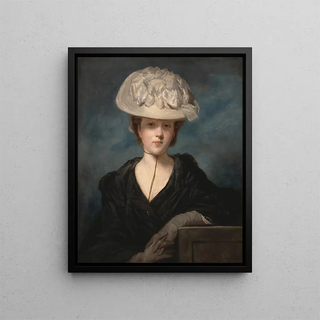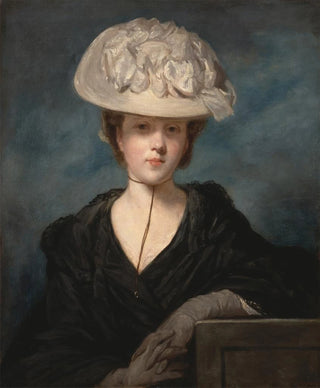Art print | Mademoiselle Mary Hickey - Sir Joshua Reynolds


View from behind

Frame (optional)
In the world of 18th-century English painting, few works manage to capture the essence of feminine beauty and refinement like "Mademoiselle Mary Hickey" by Sir Joshua Reynolds. This canvas, emblematic of the portraiture of the era, transports us to a time when art and society were deeply intertwined. Through the delicate features of Mary Hickey, Reynolds does not merely reproduce the external appearance of his model; he also reveals her character, grace, and social status. Every brushstroke, every shade of color, seems to tell a story— that of a woman who is both noble and accessible, embodying the aspirations of a rapidly changing era.
Style and uniqueness of the work
Reynolds' style is a harmonious blend of classicism and romanticism, and "Mademoiselle Mary Hickey" is a perfect example. The portrait stands out for its balanced composition, where Mary’s figure is positioned to immediately capture the viewer’s attention. The skillfully used light highlights the details of her dress and the reflections in her hair, creating a play of shadows and light that enhances her beauty. The chosen colors, both soft and vibrant, evoke an atmosphere of serenity and elegance. What makes this work unique is Reynolds' ability to transcend the simple portrait to offer a true psychological study of the model. Mary’s eyes, both sparkling and mysterious, seem to invite the viewer to discover her thoughts and dreams, establishing an intimate connection between the artwork and its admirer.
The artist and his influence
Sir Joshua Reynolds, an emblematic figure of British portraiture, marked his era with his innovative approach and his ability to capture the spirit of his contemporaries. As the first president of the Royal Academy, he played a leading role in promoting the arts in England, influencing generations of artists. His style, which combines impeccable technique with a keen sense of character psychology, paved the way for a new way of approaching portraiture. Reynolds' works, including "Mademoiselle Mary Hickey,"

Matte finish

View from behind

Frame (optional)
In the world of 18th-century English painting, few works manage to capture the essence of feminine beauty and refinement like "Mademoiselle Mary Hickey" by Sir Joshua Reynolds. This canvas, emblematic of the portraiture of the era, transports us to a time when art and society were deeply intertwined. Through the delicate features of Mary Hickey, Reynolds does not merely reproduce the external appearance of his model; he also reveals her character, grace, and social status. Every brushstroke, every shade of color, seems to tell a story— that of a woman who is both noble and accessible, embodying the aspirations of a rapidly changing era.
Style and uniqueness of the work
Reynolds' style is a harmonious blend of classicism and romanticism, and "Mademoiselle Mary Hickey" is a perfect example. The portrait stands out for its balanced composition, where Mary’s figure is positioned to immediately capture the viewer’s attention. The skillfully used light highlights the details of her dress and the reflections in her hair, creating a play of shadows and light that enhances her beauty. The chosen colors, both soft and vibrant, evoke an atmosphere of serenity and elegance. What makes this work unique is Reynolds' ability to transcend the simple portrait to offer a true psychological study of the model. Mary’s eyes, both sparkling and mysterious, seem to invite the viewer to discover her thoughts and dreams, establishing an intimate connection between the artwork and its admirer.
The artist and his influence
Sir Joshua Reynolds, an emblematic figure of British portraiture, marked his era with his innovative approach and his ability to capture the spirit of his contemporaries. As the first president of the Royal Academy, he played a leading role in promoting the arts in England, influencing generations of artists. His style, which combines impeccable technique with a keen sense of character psychology, paved the way for a new way of approaching portraiture. Reynolds' works, including "Mademoiselle Mary Hickey,"






